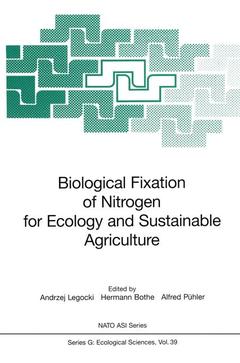Description
Biological Fixation of Nitrogen for Ecology and Sustainable Agriculture, Softcover reprint of the original 1st ed. 1997
Nato ASI Subseries G: Series, Vol. 39
Coordinators: Legocki Andrzej, Bothe Hermann, Pühler Alfred
Language: English
Publication date: 10-2012
328 p. · 15.5x23.5 cm · Paperback
328 p. · 15.5x23.5 cm · Paperback
Description
/li>Contents
/li>
Biological nitrogen fixation (BNF) - the conversion of molecular nitrogen into ammonia - is one of the most important reactions in ecology and agriculture. It is performed exclusively by microbes (prokaryotes) that live in symbiosis with plants. This book summarizes the latest research on this reaction, the participating microbes and the genetics of how their relevant genes could be transferred into the plants. In the light of a more sustainable and less ecologically damaging agriculture, this is becoming an increasingly pressing issue.
1. Structural Chemistry and Biochemistry of Nitrogenase.- Nitrogenase: Two Decades of Biochemical Genetics.- Molybdenum-Nitrogenase: Structure and Function.- 2. Signal Perception, Transduction and Cell Cycle Genes in Nodulation.- Rhizobium Nodulation Factors in Perspective.- The Host-Specific Role of Chemical Modifications at the Reducing Terminus of Lipo-Chitin Oligosaccharides.- The Complex Interaction Between Bradyrhizobiumjaponicum and its Symbiotic Host Plants.- Studies on MsENOD40 gene Expression in Alfalfa (Medicago sativa L.) and White Sweetclover (Melilotus alba Desr.).- Nod-Factor Attachment, Calcium-Fluxes, and Lipid-Transfer Proteins in Symbiotic Signal Transduction.- Degradation of Modulation Signals from Rhizobium meliloti by its Host Plants.- Induction of Root Cortical Cell Divisions by Heterologous Nodulation Factors.- ENOD40 Expression Precedes Cell Division and Affects Phytohormone Perception at the Onset of Nodulation.- ENOD40 Expression and Phytohormonal Imbalances in Nodule Organogenesis.- N-Acyl Galactosamine Inhibition of Lipo-Chitooligosaccharide Action.- Cell Cycle Reregulation During Nodule Development.- 3. Plant Genes Involved in Nodulation.- The Saga of the Nodulin Genes.- Identification of New Medicago truncatula Nodulin Genes: Comparison of two Molecular Approaches.- Plant Gene Expression During Stem Nodule Development on Sesbania rostrata.- Identification of Trans-Acting Factors Regulating Nodulin Gene Expression.- Analysis of Genes Expressed in Root Nodules of Broad Bean (Vicia faba L.).- Regulation of Bradyrhizobium japonicum hemB, a Heme Biosynthesis Gene.- 4. Bacterium - Plant Surface Interaction.- Rhizobial Capsular and Lipopolysaccharides: Evidence for Their Importance in Rhizobium-Legume Symbiosis.- Changes in Rhizobium Lipopolysaccharide Structure Induced by Host Compounds.- Symbiotic Suppression of the Medicago sativa Plant Defence System by Rhizobium meliloti Oligosaccharides.- Biochemical and Molecular Analyses of Rhizobial Responses to Legume Flavonoids.- Flavonoid-Inducible Regions in the Symbiotic Plasmid of Rhizobium etli.- Azospirillum Genes Involved in Chemotaxis and Adhesion to Plant Roots.- 5. Molecular Microbial Ecology.- Molecular Microbial Ecology.- Plant Regulation of Root Colonization by Rhizobium meliloti.- Host-Controlled Restriction of Nodulation by Bradyrhizobium japonicum strain USDA 110 and Characterization of a Gene Regulating Nodulation.- Enhancing the Potential of Microbial Inoculants Through Molecular Microbial Ecology.- 6. Nitrogen Fixing Systems.- Nitrogen Fixation in Rhodospirillum rubrum: Regulation of Activity and Generation of Reductant.- Molecular Studies of the Electron Transport Pathway to Nitrogenase in Rhodobacter capsulatus.- Regulation of Alternative Nitrogenase Systems by Environmental Factors in the Cyanobacterium Anabaena variabilis.- Heterocyst Differentiation and Nitrogen Fixation in Cyanobacteria.- Trichodesmium Has Cells Specialized for Nitrogen Fixation but Lacks Heterocysts.- 7. Nitrogen Fixation in Sustainable Agriculture.- Biological Nitrogen Fixation for Sustainable Agriculture.- Enhanced Agricultural Sustainability Through Biological Nitrogen Fixation.- Towards the Application of Nitrogen Fixation Research to Forestry and Agriculture.- Genetic Potential of Plants for Improving the Beneficial Microbe Interactions.- DNA-Probing as a Tool to Monitor the Distribution of N2-Fixing, Denitrifying and Nitrifying Bacteria in Soils.- 8. Carbon-Nitrogen Metabolism in Symbiotic Systems.- Carbon-Nitrogen Metabolism in Symbiotic Systems: Integration and Overall Regulation.- Assimilation of Reduced Nitrogen in Tropical Legume Nodules: Regulation of de novo Purine Biosynthesis and Peroxisome Proliferation.- Contrasting C Supply, N Assimilation and N Transport Across a Range of Symbiotic Plants.- Robinia pseudoacacia, a Model Tree Legume.- Unsolved Mysteries in Carbon Metabolism in Legume Nodules.- Phosphorous Deficiency Increases the Respiratory Cost of Symbiotic N2 Fixation.- Carbon and Nitrogen Metabolism in Plant-Derived Ineffective Nodules of Pea (Pisum sativum L.).- 9. Oxygen Regulation in Nitrogen fixation.- Genetic Regulation and Bioenergetics of Symbiotic Nitrogen Fixation in Bradyrhizobium japonicum.- Dynamic Control of Oxygen Diffusion Resistance in Nodules.- Is the Variable Oxygen Permeability in Nodules a Physical or a Physiological Phenomenon?.- Regulation of Nitrogen Fixation Genes by the NIFA and NIFL Regulatory Proteins.- 10. Model Plants for Nitrogen Fixation and Legume Genetics.- Model Plants for Nitrogen Fixation: Genetic and Molecular Tools for Analysing the Infection and Infestation of Clovers.- Recent Advances in the Molecular Genetics of the Model Legume Lotus japonicus.- Molecular Genetics of a Model-Plant: Medicago truncatula.- Advances in Molecular Characterization of the Yellow Lupin - Bradyrhizobium sp. (Lupinus) Symbiotic model.- Actinorhizal Nodules.- Molecular and Genetic Insights into Shoot Control of Nodulation in Soybean.- Effect of Nitrogen Nutrition Pathways on the Quality of Nitrogen Storage Compounds in legumes.- Genetic Linkage Map of Alfalfa (Medicago sativa) and its Use to Map Seed Protein Genes as well as Genes Involved in Leaf Morphogenesis and Symbiotic Nitrogen Fixation.- Genetic Transformation and Regeneration of Legumes.- 11. Coevolution of Symbiotic Systems.- Phylogenetic Perspectives on the Origins and Evolution of Nodulation in the Legumes and Allies.- Co-evolution of Legume-Rhizobial Symbioses: is it Essential for Either Partner?.- Interactions between Diazotrophs and Grasses.- Have Common Plant Systems Co-evolved in Fungal and Bacterial Root Symbioses?.- Nitrogen Fixing Systems and Evolution of Plant Hemoglobins.
© 2024 LAVOISIER S.A.S.
These books may interest you

Soil Nitrogen Ecology 189.89 €



